Christophe Cruz
ICB, UB
Enhancing Knowledge Graph Construction: Evaluating with Emphasis on Hallucination, Omission, and Graph Similarity Metrics
Feb 07, 2025Abstract:Recent advancements in large language models have demonstrated significant potential in the automated construction of knowledge graphs from unstructured text. This paper builds upon our previous work [16], which evaluated various models using metrics like precision, recall, F1 score, triple matching, and graph matching, and introduces a refined approach to address the critical issues of hallucination and omission. We propose an enhanced evaluation framework incorporating BERTScore for graph similarity, setting a practical threshold of 95% for graph matching. Our experiments focus on the Mistral model, comparing its original and fine-tuned versions in zero-shot and few-shot settings. We further extend our experiments using examples from the KELM-sub training dataset, illustrating that the fine-tuned model significantly improves knowledge graph construction accuracy while reducing the exact hallucination and omission. However, our findings also reveal that the fine-tuned models perform worse in generalization tasks on the KELM-sub dataset. This study underscores the importance of comprehensive evaluation metrics in advancing the state-of-the-art in knowledge graph construction from textual data.
Knowledge Graph for NLG in the context of conversational agents
Jul 04, 2023Abstract:The use of knowledge graphs (KGs) enhances the accuracy and comprehensiveness of the responses provided by a conversational agent. While generating answers during conversations consists in generating text from these KGs, it is still regarded as a challenging task that has gained significant attention in recent years. In this document, we provide a review of different architectures used for knowledge graph-to-text generation including: Graph Neural Networks, the Graph Transformer, and linearization with seq2seq models. We discuss the advantages and limitations of each architecture and conclude that the choice of architecture will depend on the specific requirements of the task at hand. We also highlight the importance of considering constraints such as execution time and model validity, particularly in the context of conversational agents. Based on these constraints and the availability of labeled data for the domains of DAVI, we choose to use seq2seq Transformer-based models (PLMs) for the Knowledge Graph-to-Text Generation task. We aim to refine benchmark datasets of kg-to-text generation on PLMs and to explore the emotional and multilingual dimensions in our future work. Overall, this review provides insights into the different approaches for knowledge graph-to-text generation and outlines future directions for research in this area.
Imbalanced Multi-label Classification for Business-related Text with Moderately Large Label Spaces
Jun 12, 2023Abstract:In this study, we compared the performance of four different methods for multi label text classification using a specific imbalanced business dataset. The four methods we evaluated were fine tuned BERT, Binary Relevance, Classifier Chains, and Label Powerset. The results show that fine tuned BERT outperforms the other three methods by a significant margin, achieving high values of accuracy, F1 Score, Precision, and Recall. Binary Relevance also performs well on this dataset, while Classifier Chains and Label Powerset demonstrate relatively poor performance. These findings highlight the effectiveness of fine tuned BERT for multi label text classification tasks, and suggest that it may be a useful tool for businesses seeking to analyze complex and multifaceted texts.
Unlocking Insights into Business Trajectories with Transformer-based Spatio-temporal Data Analysis
Jun 07, 2023Abstract:The world of business is constantly evolving and staying ahead of the curve requires a deep understanding of market trends and performance. This article addresses this requirement by modeling business trajectories using news articles data.
Semantic HMC for Big Data Analysis
Dec 02, 2014

Abstract:Analyzing Big Data can help corporations to im-prove their efficiency. In this work we present a new vision to derive Value from Big Data using a Semantic Hierarchical Multi-label Classification called Semantic HMC based in a non-supervised Ontology learning process. We also proposea Semantic HMC process, using scalable Machine-Learning techniques and Rule-based reasoning.
From 9-IM Topological Operators to Qualitative Spatial Relations using 3D Selective Nef Complexes and Logic Rules for bodies
Jan 21, 2013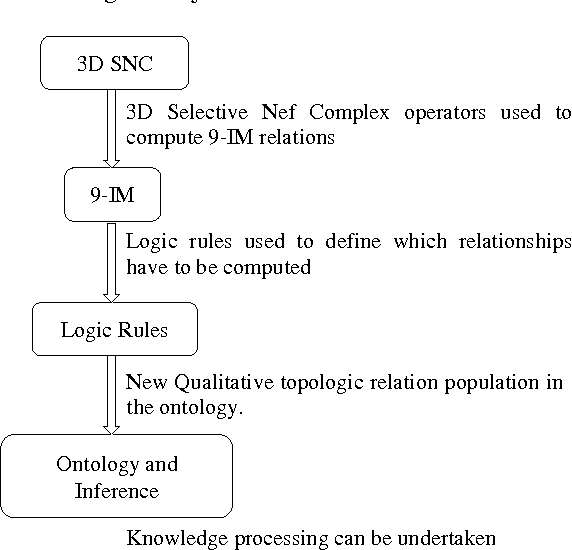
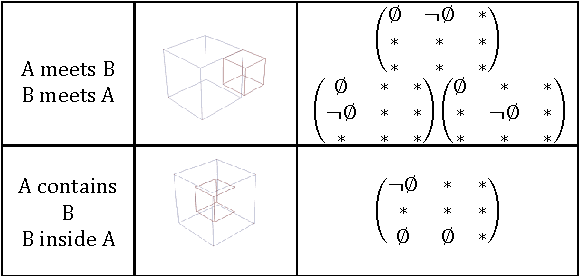
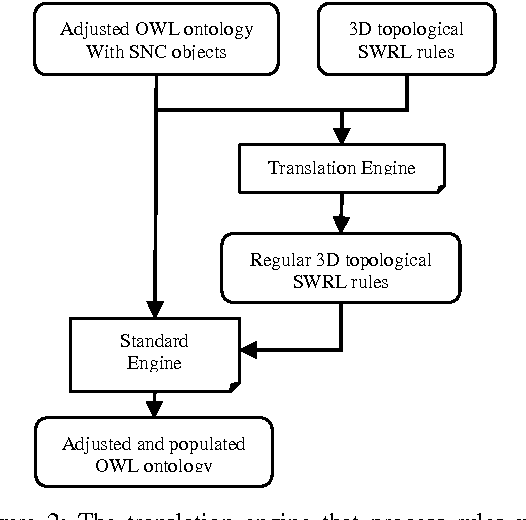

Abstract:This paper presents a method to compute automatically topological relations using SWRL rules. The calculation of these rules is based on the definition of a Selective Nef Complexes Nef Polyhedra structure generated from standard Polyhedron. The Selective Nef Complexes is a data model providing a set of binary Boolean operators such as Union, Difference, Intersection and Symmetric difference, and unary operators such as Interior, Closure and Boundary. In this work, these operators are used to compute topological relations between objects defined by the constraints of the 9 Intersection Model (9-IM) from Egenhofer. With the help of these constraints, we defined a procedure to compute the topological relations on Nef polyhedra. These topological relationships are Disjoint, Meets, Contains, Inside, Covers, CoveredBy, Equals and Overlaps, and defined in a top-level ontology with a specific semantic definition on relation such as Transitive, Symmetric, Asymmetric, Functional, Reflexive, and Irreflexive. The results of the computation of topological relationships are stored in an OWL-DL ontology allowing after what to infer on these new relationships between objects. In addition, logic rules based on the Semantic Web Rule Language allows the definition of logic programs that define which topological relationships have to be computed on which kind of objects with specific attributes. For instance, a "Building" that overlaps a "Railway" is a "RailStation".
* arXiv admin note: substantial text overlap with arXiv:1301.4780
Integration of knowledge to support automatic object reconstruction from images and 3D data
Jan 21, 2013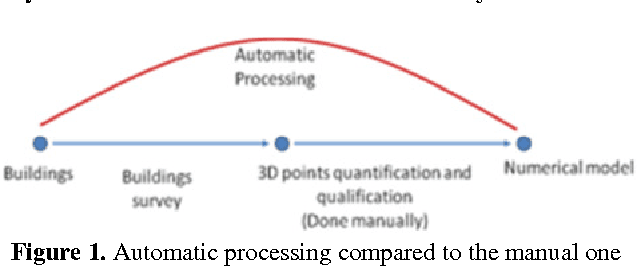

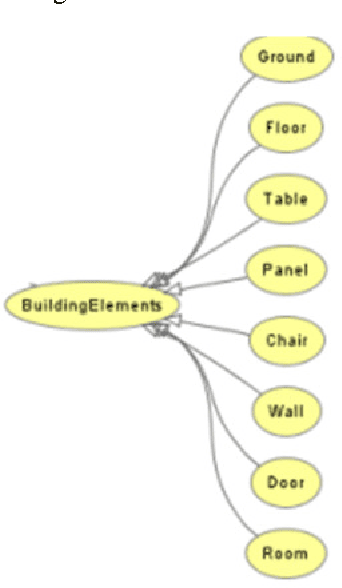

Abstract:Object reconstruction is an important task in many fields of application as it allows to generate digital representations of our physical world used as base for analysis, planning, construction, visualization or other aims. A reconstruction itself normally is based on reliable data (images, 3D point clouds for example) expressing the object in his complete extent. This data then has to be compiled and analyzed in order to extract all necessary geometrical elements, which represent the object and form a digital copy of it. Traditional strategies are largely based on manual interaction and interpretation, because with increasing complexity of objects human understanding is inevitable to achieve acceptable and reliable results. But human interaction is time consuming and expensive, why many researches has already been invested to use algorithmic support, what allows to speed up the process and to reduce manual work load. Presently most of such supporting algorithms are data-driven and concentate on specific features of the objects, being accessible to numerical models. By means of these models, which normally will represent geometrical (flatness, roughness, for example) or physical features (color, texture), the data is classified and analyzed. This is successful for objects with low complexity, but gets to its limits with increasing complexness of objects. Then purely numerical strategies are not able to sufficiently model the reality. Therefore, the intention of our approach is to take human cognitive strategy as an example, and to simulate extraction processes based on available human defined knowledge for the objects of interest. Such processes will introduce a semantic structure for the objects and guide the algorithms used to detect and recognize objects, which will yield a higher effectiveness. Hence, our research proposes an approach using knowledge to guide the algorithms in 3D point cloud and image processing.
Knowledge Base Approach for 3D Objects Detection in Point Clouds Using 3D Processing and Specialists Knowledge
Jan 21, 2013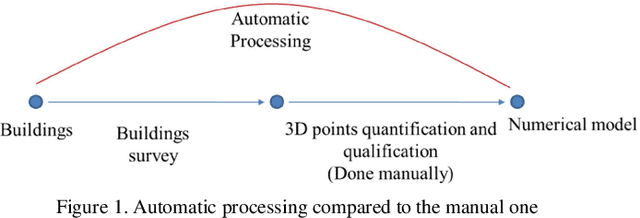
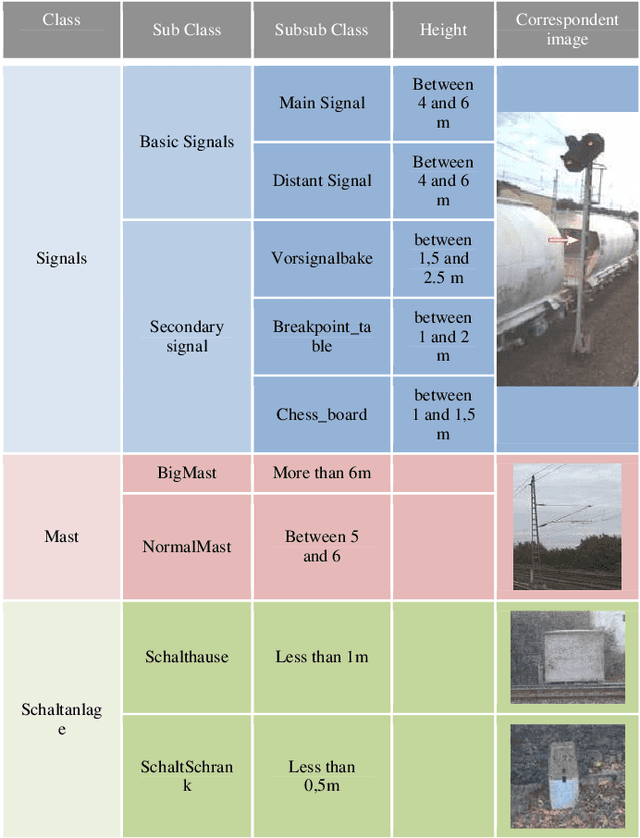
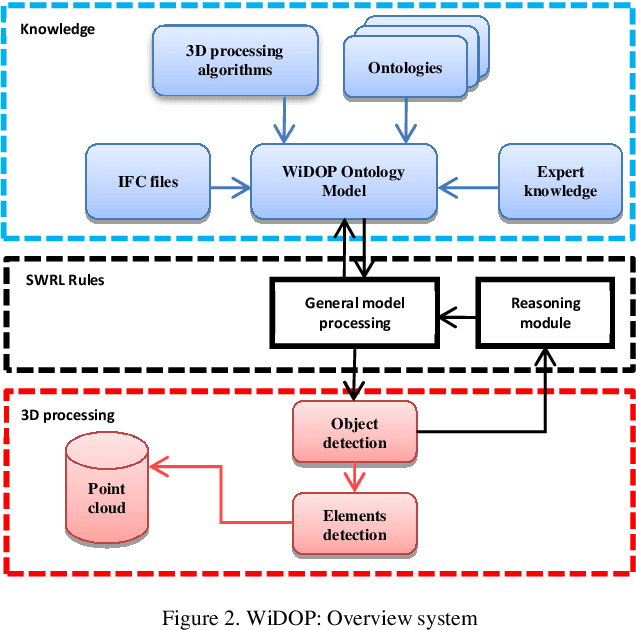
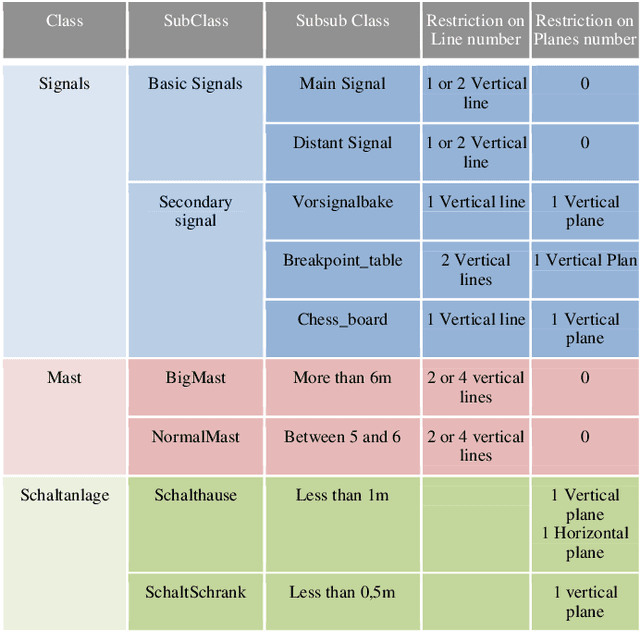
Abstract:This paper presents a knowledge-based detection of objects approach using the OWL ontology language, the Semantic Web Rule Language, and 3D processing built-ins aiming at combining geometrical analysis of 3D point clouds and specialist's knowledge. Here, we share our experience regarding the creation of 3D semantic facility model out of unorganized 3D point clouds. Thus, a knowledge-based detection approach of objects using the OWL ontology language is presented. This knowledge is used to define SWRL detection rules. In addition, the combination of 3D processing built-ins and topological Built-Ins in SWRL rules allows a more flexible and intelligent detection, and the annotation of objects contained in 3D point clouds. The created WiDOP prototype takes a set of 3D point clouds as input, and produces as output a populated ontology corresponding to an indexed scene visualized within VRML language. The context of the study is the detection of railway objects materialized within the Deutsche Bahn scene such as signals, technical cupboards, electric poles, etc. Thus, the resulting enriched and populated ontology, that contains the annotations of objects in the point clouds, is used to feed a GIS system or an IFC file for architecture purposes.
* ISSN: 1942-2679. arXiv admin note: text overlap with arXiv:1301.4783
Toward the Automatic Generation of a Semantic VRML Model from Unorganized 3D Point Clouds
Jan 21, 2013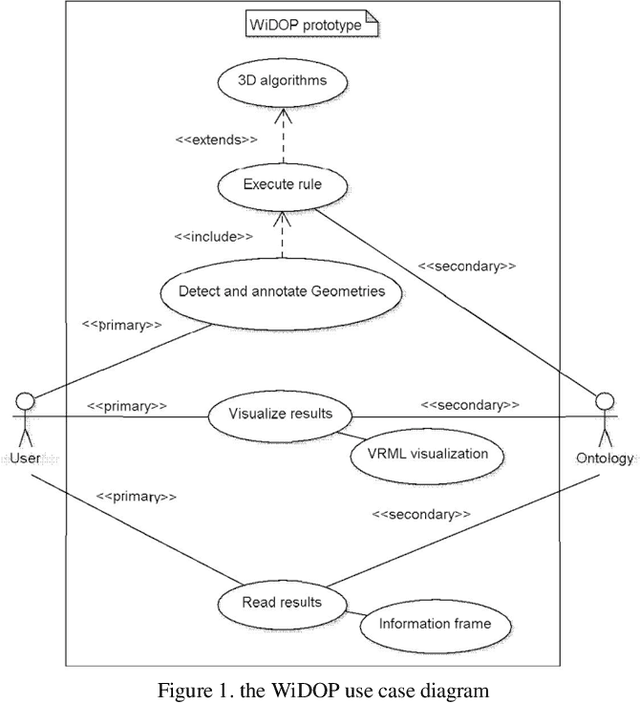

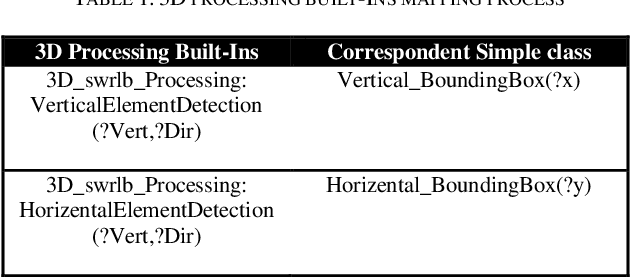

Abstract:This paper presents our experience regarding the creation of 3D semantic facility model out of unorganized 3D point clouds. Thus, a knowledge-based detection approach of objects using the OWL ontology language is presented. This knowledge is used to define SWRL detection rules. In addition, the combination of 3D processing built-ins and topological Built-Ins in SWRL rules aims at combining geometrical analysis of 3D point clouds and specialist's knowledge. This combination allows more flexible and intelligent detection and the annotation of objects contained in 3D point clouds. The created WiDOP prototype takes a set of 3D point clouds as input, and produces an indexed scene of colored objects visualized within VRML language as output. The context of the study is the detection of railway objects materialized within the Deutsche Bahn scene such as signals, technical cupboards, electric poles, etc. Therefore, the resulting enriched and populated domain ontology, that contains the annotations of objects in the point clouds, is used to feed a GIS system.
* arXiv admin note: substantial text overlap with arXiv:1301.4991, arXiv:1301.4783
From 3D Point Clouds To Semantic Objects An Ontology-Based Detection Approach
Jan 21, 2013
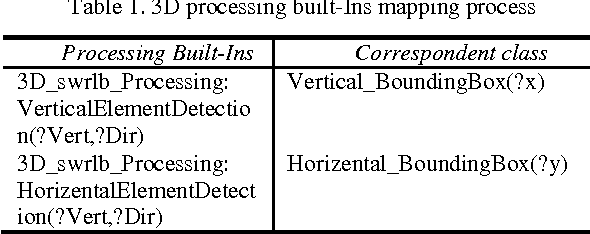
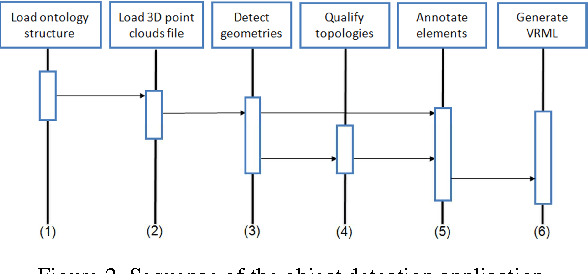
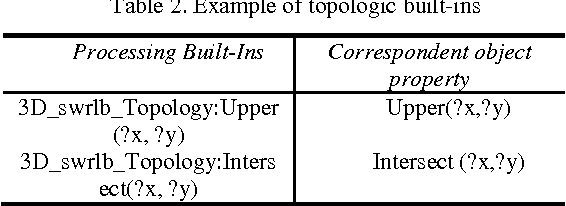
Abstract:This paper presents a knowledge-based detection of objects approach using the OWL ontology language, the Semantic Web Rule Language, and 3D processing built-ins aiming at combining geometrical analysis of 3D point clouds and specialist's knowledge. This combination allows the detection and the annotation of objects contained in point clouds. The context of the study is the detection of railway objects such as signals, technical cupboards, electric poles, etc. Thus, the resulting enriched and populated ontology, that contains the annotations of objects in the point clouds, is used to feed a GIS systems or an IFC file for architecture purposes.
 Add to Chrome
Add to Chrome Add to Firefox
Add to Firefox Add to Edge
Add to Edge